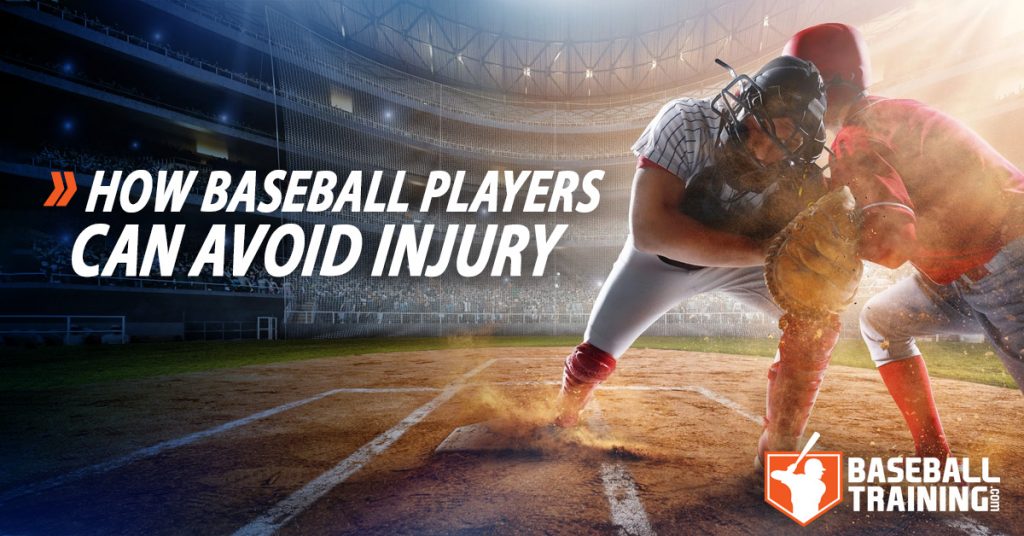Whether your goal is related to hitting harder, throwing further, running faster, or just improving your all-round baseball performance — the best thing you can do for training is to be able to do training properly in the first place.
It’s not enough to just exercise towards something, you need to be able to do it in a way that is pain-free, progressive, and specific to functional baseball performance.
In a sport that is as injury prone as baseball, this means you must take the necessary steps in your training to reduce injury risk at all costs.
The truth is that exercise is one of the most low injury-risk activities you could ever do. If you’re following a well-designed program with good technique, the chances of you getting injured are incredibly low.
In fact, training has been demonstrated on many occasions to reduce injury risk since you can effectively strengthen the tendons, ligaments, muscles, and bones of the body to make it more resilient to the high-impact moments of baseball.
But, inevitably injury (or just getting hurt) creeps up on us all in one way or another. If it does, use these strategies to make sure you both:
- Don’t aggravate it.
- Prevent injury from happening again.
No Pain No Gain Is Not A Real Thing
When you’re hurt or injured, training “through the pain” is one of the dumbest things you could ever do.
Although this should be obvious, many athletes still use exercises that they know cause pain. This is ego training, and not real training.
If you’re in pain, it’s highly likely that you’re delaying the healing process, or worse, damaging the tissue even further. There’s nothing “hardcore” about this, it only hurts your performance and ultimately you are letting your team down.
Don’t exercise in pain, exercise around pain.
If an exercise hurts you for whatever reason, find a modification that doesn’t. There are hundreds of exercise variations for each muscle group out there, you don’t “need” to only do one of them.
Be Careful With Old Injuries
Injury risk is always increased in those who have previously had an injury in the same area.
Most strength and conditioning professionals know this, but many baseball athletes don’t. They will hurt themselves doing a certain movement, and then go back to doing that movement right away afterwards without modifying their warm up or anything at all.
This is a mistake.
Here are some tips I can offer you about working a previously injured area:
- Progress the amount of weight you use and the total amount of sets/reps you do very carefully in previous injury sites.
- Be hyper-careful about performing the same movement again. For example, if you hurt your ankle doing broad jumps before, be very careful when doing broad jumps again in the future.
- Even though you have to be very careful, don’t neglect previous injury sites either. If you just stop training them, they will become weak and much more susceptible to injury in the future due to their relative weakness in comparison to your other body parts.
- Experience tells me to treat an injury like it’s still an injury for one month even after you have “healed”. Many of us have this one day where we wake up and we’re like “wow, this feels great again!” — it’s not, give it a month.
Do More Conditioning Workouts
Fatigue is a very underrated risk factor for injuries in sports.
Put very simply, the lower your conditioning levels are, the faster you fatigue.
And the faster you fatigue, the faster your technique start to go to crap.
And the faster your technique starts to go to crap, the more and more likely your chance of getting injured becomes.
For this reason, improving your conditioning levels can help you resist fatigue and therefore prevent unnecessary injury risk.
This conditioning factor becomes as much of a positive tool for reducing injury risk during a game as it does in the gym.
Get To Bed On Time
There has been an explosion of research on how sleep impacts body composition and athletic performance in the past few years. But, what nobody seems to be talking about is how it is also directly linked to injury risk as well.
Multiple studies now have all demonstrated that adolescents and adults who are not given at least 7 hours of sleep per night are all at a greater increased risk of injury.
Getting 7-9 hours of sleep per night is critical for baseball performance on many levels, injury risk being only one of those levels.
Final Thoughts
It’s important to note that I am not talking about causation here, I am merely talking about correlation.
Doing the above factors wrong increases your risk (correlation) for injury, but it doesn’t guarantee (causation) you will/will not get injured.
For baseball, it’s smart to always stay on the side of caution and progress forward from there, anything less would be a sub-optimal approach.
—
Are you looking for a completely “done for you” baseball specific program to improve your performance?
Then I have what you’re missing, check out the selection of high-performance baseball training programs and start dominating your league today!
